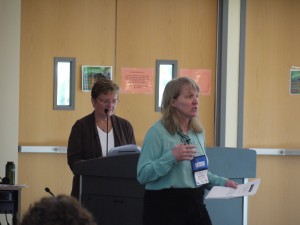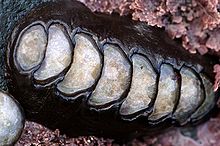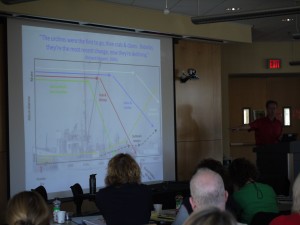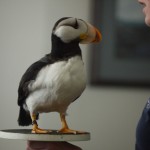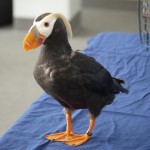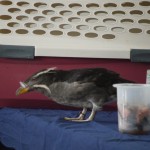After a late night return from the Seward, we were all running on fumes for the Wednesday morning early start. Library Dean Steve Rollins addressed the group as a reschedule from Monday morning.
We discussed engaging new audiences, but we all looked like the same audience that has been here all week. HAHAHA.  But seriously, the opening field of data curatorship is ripe for the help of librarians to organize, publicize and help patrons learn to repurpose data. Data is the new currency. If libraries can become repositories for not just documents, but complete data sets, we’ll be rich. Once more we learned of the cutting edge work taking place at the Biodiversity Heritage Library & Encyclopedia of Life. We then learned the important questions to ask when conducting a data interview with patrons looking of for our help in storing data sets. Finally, we talked about how we can help patrons cite data and publish data sets with DOI’s embeddded in publications. After a short break, the panel of experts convened to answer more questions from the audience about using our skills to help patrons with their data sets.
During lunch folks gathered at the Guin Auction tables to put in bids, but we extended the deadline for bidding until 1:40 pm after the PM break.
After lunch, we had brief presentations on the various posters submitted for members. We then all walked out to view the posters and talk to the authors directly. This segued into our PM break. During the last few minutes of bidding at the Guin Auction, we had some rough and tumble bidding going on. Lots of last minute bids on the very desirable items.
Following the PM break, we were given presentations by our vendors/sponsors. Inter-Research was represented by Ian Stewart and Thomson Reuters was represented by Kristen Culp. We love our sponsors and hope to see them all in Fort Lauderdale, Florida next year. Their generosity and input into the program are very much appreciated.
In the meantime, assisted by Jen Walton, I gathered up all the Guin Auction items and sorted them into winning bid piles. Just about everyone got something. We had over 80 items this year and earned $1220 for the Guin Fund. Again, thanks to all the members for the donation of auction items and for their generous bids and donations.
While this was going on, the Green Flash was ably moderated by Kristen LaBonte. Lots of topics this year. I did make the session in time to see the 2009 Antarctic film winner “Legend of the Golden Roll”. For those who attended the Belgium conference, you’ll remember this hilarious short film about retrieving toilet paper from an ice cave in Antarctica.
Ending a bit early, we all hurried out to get back to the hotel to change (or not) for the evening banquet at the Hotel Captain Cook. Cook Inlet is the large body of water named for Captain Cook who spent quite some time looking for the Northwest Passage.
The group gathered in the lobby of the hotel and boarded the Magic Bus (our favorite form of transport as it was much more reliable and friendly than the hotel shuttle). Anyway, we arrived at the hotel and did not realize there were 3 separate towers in the hotel. We were supposed to be in the Quarterdeck Restaurant on the top floor of tower 1. Drifting around, the herd wandered until we found a set of likely elevators. Well, these were the tower 3 elevators. A brief tour of the tower 3 top floor proved fruitless, so we elevatored back down to the main floor to wander again only to find Daria & Celia waiting at the bank of tower 1 elevators to direct us to the proper location. Mesmerized by the view, we walked in a daze to the tables and continued to stare at Cook Inlet and the various mountain ranges. Transfixed by the play of sun & cloud, we buzzed with talk of the conference, personal stories and various small talk until the buffet was finally opened. Once again, our palates were amazed with tasty dishes including halibut, chicken, vegetarian lasagna, new potatoes and a variety of salads. The dessert portion was beautifully displayed with a wide variety of tarts, cakes & fresh fruit. Dinner was initially accompanied by lovely classical guitar.
However, the best part of the evening was Dr Leslie Cornick talking about the endangered beluga whales of Cook Inlet. We were regaled with biology, tales of the endangered species act, habitat modification. We were a bit disappointed that she didn’t have her sound file loaded so we could listen to beluga whale acoustics, but here’s YouTube video of Beethoven demonstrating sounds at the Point Defiance Zoo: http://www.youtube.com/watch?v=SvsvcnzFy-g or here’s a sound file from National Geographic: http://animals.nationalgeographic.com/animals/mammals/beluga-whale/ I would have loved to have Dr Cornick continue. Her passion for these animals was contagious.
Finally, the dinner ended and the accordion player was set up to continue the evening with dancing and other sorts of frolic. Those of us not fully recovered from the previous late night hobbled off to find the return bus to the hotel to drop into our beds and sleep.
Lenora
StreamNet Regional Librarian
Columbia River Inter-Tribal Fish Commission
http://www.streamnetlibrary.org





